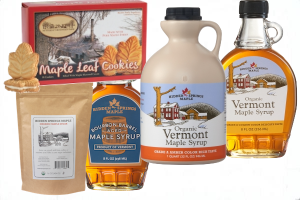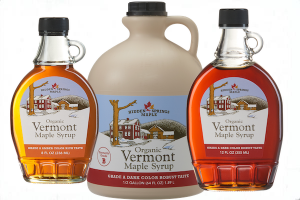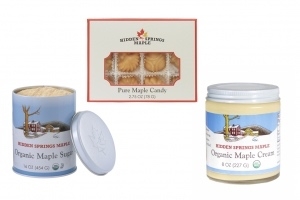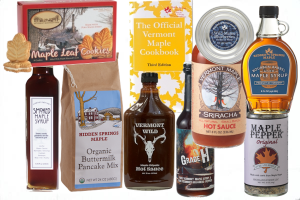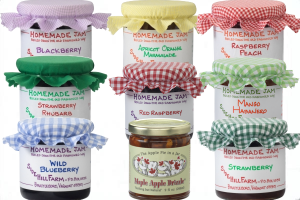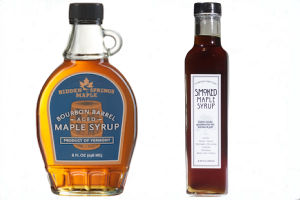Frequently Asked Questions
Have some questions about our syrup? Here are a few facts about Hidden Springs Maple 100% pure Vermont maple syrup. If you have any additional questions, not answered here, don’t hesitate to send us an email
Vermont adopted new international grading standards as of Jan 1, 2015. The old Vermont syrup grades have been replaced by four new international grades as follows: Grade A Golden Color with Delicate Taste, Grade A Amber Color with Rich Taste, Grade A Dark with Robust Taste and Grade A Very Dark with Strong Taste. You can see how the new grades map to the old Vermont grades on our About Our Syrup page at:
Although all Hidden Springs maple syrup is made in a safe and sustainable manner, Hidden Springs certified organic maple syrup provides the highest level of certainty that each and every step of the maple production process adheres to the strictest guidelines for forest sustainability and food safety. Read our Organic page for more information.
With responsible forest management, tapping a maple tree does not harm the tree. The North American Maple Project has monitored hundreds of maples in Vermont for 20 years, and has found no significant difference between the health of maples tapped yearly for making maple syrup and maples that have never been tapped. Refer to the North American Maple Producer’s Manual 2nd edition for more information about making maple syrup, https://mapleresearch.org/pub/wilmot_project-2/
That’s a tough question! While all the grades are excellent, each grade has a subtly different flavor and most of our customers have their own preferences. Each grade has the same weight and sweetness (maple sugar content). The color and flavor varies by grade. Our Amber Rich is produced from the first-run maple sap harvested during early March and has a light color and delicate flavor. Dark Robust is our mid-season product, which has identical maple sugar content but a darker color and stronger flavor. Very Dark Strong is our late-season product. It has a stronger flavor that is prized by Vermont maple syrup lovers at the table and for cooking. Try out the different grades and decide for yourself which one you like best!
Maple syrup should be stored in a cool place until opened. Once opened it should be refrigerated.
For long term storage, maple syrup retains its flavor best when kept in the freezer. It will not freeze solid, but become very thick and then return to its former viscosity upon warming.
If mold is found on maple syrup, the syrup should be discarded.
We do sell 8 and 12 glass containers on our web site, though not on other sites like Amazon. There are a few reasons why we use mostly plastic. First, it's more durable for shipping and second the syrup stores better in plastic. Syrup stored in glass is more likely to develop mold on the top. This can happen when sunlight hits the contents and causes condensation in the air pocket in the neck area of the glass bottle.
No. The only ingredient in Hidden Springs Maple syrup is maple sap from which water has been boiled off to achieve a density of 66.9% sugar.
To be classified as Vermont maple syrup, the syrup must be produced in Vermont, have a 66.9% sugar density, and conform to the Vermont grading standards for translucency. The grading standards for density and translucency vary slightly between Vermont, other US states, and Canada. Whereas Vermont maple syrup must be 66.9% density, in Canada syrup only needs to be at least 66 % sugar to qualify as "maple syrup".
“Off flavor” maple syrup may have either a fruity or apple-y taste or a bitter after-taste. There are several factors that can contribute to “off-flavor” maple syrup. These include changes in the sap, such as fermentation when it has been left sitting too long; and changes in the tree, such as "buddy sap" late in the season when budding has begun. Even a small portion of “off flavor” maple syrup when blended with otherwise good quality maple syrup may compromise the quality of the entire batch. This is a key reason why “single-source”, maple syrup from a small farm is often a better value than maple syrup typically found in large grocery stores. Maple syrup is like any other food: many people prefer to buy it from a trusted source.
The answer depends on how sweet the maple sap is. The sweeter the sap, the less it takes to make one gallon of syrup. However, a good rule of thumb is 40:1. It takes approximately 40 gallons of maple sap to produce one gallon of maple syrup.
Eighty percent of the world-wide annual production of maple syrup comes from Canada. The vast majority of Canadian syrup comes from an area of Quebec just north of the Vermont border. Eight percent of the annual production of maple syrup comes from Vermont. The remaining twelve percent of maple syrup comes from other states in the United States.
Pure maple syrup contains nothing but natural maple sap which has been evaporated to concentrate it. Pure maple syrup contains no additives. On the other hand, the primary ingredient for most artificial syrups such as Log Cabin or Aunt Jemima’s is usually high fructose corn syrup flavored with sotolon. Québécois sometimes refer to imitation maple syrup as sirop de poteau ("pole syrup"), a joke referring to the syrup as having been made by tapping telephone poles.
Log Cabin All Natural Syrup is primarily artificial syrup marketed as real maple syrup. Log Cabin All Natural Syrup contains natural brown rice sugar, water, caramel color, xanthan gum, a natural thickener, and 4 % maple syrup. Recently, there has been a significant amount of discussion about the packaging, labeling and super-market shelf placement of Log Cabin All Natural Syrup. The product is packaged in a brown bottle, which is similar to the bottle that real maple syrup is packaged in. The label states that the product is “all natural”. However, there is no state or federal approved definition of “natural”. In addition the product is frequently displayed on super-market shelves, alongside real maple syrup. See http://7d.blogs.com/blurt/2010/09/fake-syrup-becomes-more-natural.html for more information.
Crystallization occasionally occurs in maple syrup. It is a natural occurrence. Crystallization occurs more frequently in Golden Delicate maple syrup. The crystals are harmless. The crystals can be melted down in a pan on your stove or simply discarded.
Yes, Hidden Springs Vermont Maple Syrup is vegan. The only ingredient is Maple Sap, which is vegan. For the processing of the sap, we use organic safflower oil as a defoamer, and diatomaceous earth as an occasional filtering agent. Both safflower oil and diatomaceous are considered vegan.

